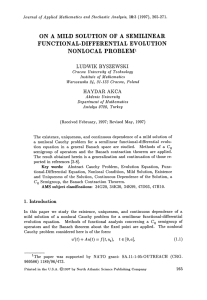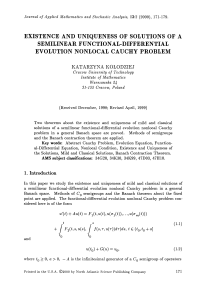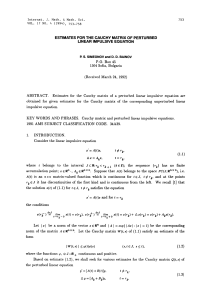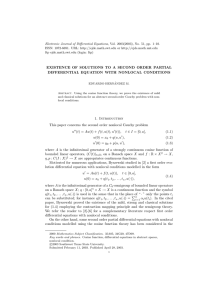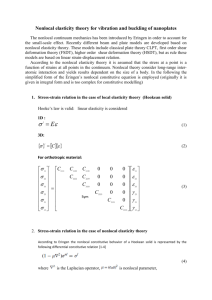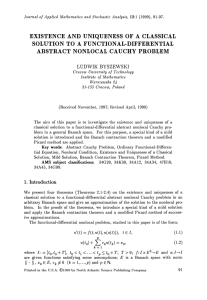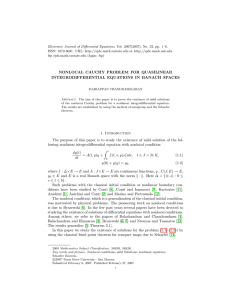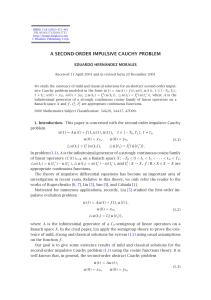IMPULSIVE FUNCTIONAL-DIFFERENTIAL EQUATIONS WITH NONLOCAL CONDITIONS
advertisement
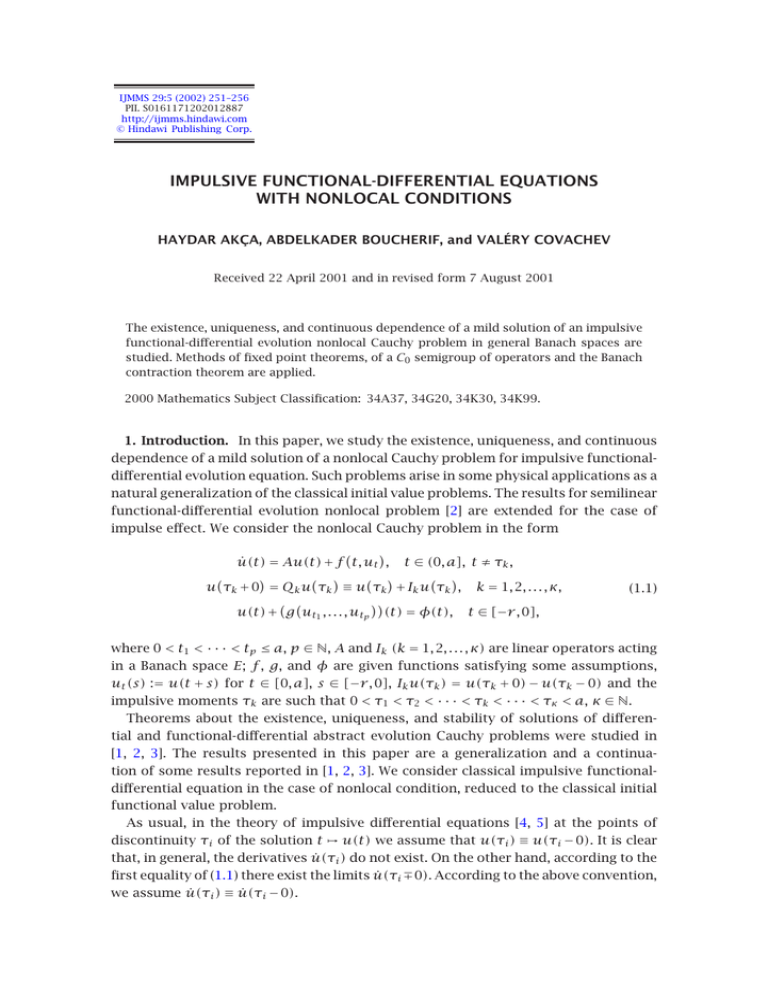
IJMMS 29:5 (2002) 251–256
PII. S0161171202012887
http://ijmms.hindawi.com
© Hindawi Publishing Corp.
IMPULSIVE FUNCTIONAL-DIFFERENTIAL EQUATIONS
WITH NONLOCAL CONDITIONS
HAYDAR AKÇA, ABDELKADER BOUCHERIF, and VALÉRY COVACHEV
Received 22 April 2001 and in revised form 7 August 2001
The existence, uniqueness, and continuous dependence of a mild solution of an impulsive
functional-differential evolution nonlocal Cauchy problem in general Banach spaces are
studied. Methods of fixed point theorems, of a C0 semigroup of operators and the Banach
contraction theorem are applied.
2000 Mathematics Subject Classification: 34A37, 34G20, 34K30, 34K99.
1. Introduction. In this paper, we study the existence, uniqueness, and continuous
dependence of a mild solution of a nonlocal Cauchy problem for impulsive functionaldifferential evolution equation. Such problems arise in some physical applications as a
natural generalization of the classical initial value problems. The results for semilinear
functional-differential evolution nonlocal problem [2] are extended for the case of
impulse effect. We consider the nonlocal Cauchy problem in the form
u̇(t) = Au(t) + f t, ut , t ∈ (0, a], t ≠ τk ,
u τk + 0 = Qk u τk ≡ u τk + Ik u τk , k = 1, 2, . . . , κ,
u(t) + g ut1 , . . . , utp (t) = φ(t), t ∈ [−r , 0],
(1.1)
where 0 < t1 < · · · < tp ≤ a, p ∈ N, A and Ik (k = 1, 2, . . . , κ) are linear operators acting
in a Banach space E; f , g, and φ are given functions satisfying some assumptions,
ut (s) := u(t + s) for t ∈ [0, a], s ∈ [−r , 0], Ik u(τk ) = u(τk + 0) − u(τk − 0) and the
impulsive moments τk are such that 0 < τ1 < τ2 < · · · < τk < · · · < τκ < a, κ ∈ N.
Theorems about the existence, uniqueness, and stability of solutions of differential and functional-differential abstract evolution Cauchy problems were studied in
[1, 2, 3]. The results presented in this paper are a generalization and a continuation of some results reported in [1, 2, 3]. We consider classical impulsive functionaldifferential equation in the case of nonlocal condition, reduced to the classical initial
functional value problem.
As usual, in the theory of impulsive differential equations [4, 5] at the points of
discontinuity τi of the solution t u(t) we assume that u(τi ) ≡ u(τi − 0). It is clear
that, in general, the derivatives u̇(τi ) do not exist. On the other hand, according to the
first equality of (1.1) there exist the limits u̇(τi ∓0). According to the above convention,
we assume u̇(τi ) ≡ u̇(τi − 0).
252
HAYDAR AKÇA ET AL.
Throughout, we assume that E is a Banach space with norm · , A is the infinitesimal generator of a C0 semigroup {T (t)}t≥0 on E, D(A) is the domain of A, and
M := sup
t∈[0,a]
T (t)
BL(E, E) .
(1.2)
Let f : [0, a] × C([−r , 0], E) → E. Introduce the following assumptions:
(H1) for every w ∈ C([−r , a], E) and t ∈ [0, a], f (·, wt ) ∈ C([0, a], E);
(H2) there exists a constant L > 0 such that
f t, wt − f t, w̃t E
≤ L1 w − w̃ C([−r ,t], E) for w, w̃ ∈ C [−r , a], E , t ∈ [0, a],
Ik v ≤ L2 vE for v ∈ E, k = 1, 2, . . . , κ,
E
L = max L1 , L2 .
(1.3)
Let g : [C([−r , 0], E)]p → C([−r , 0], E). Then we have the following assumptions:
(H3) there exists a constant K > 0 such that
g wt , . . . , wt
(t) − g w̃t1 , . . . , w̃tp (t) ≤ K w − w̃ C([−r ,a], E)
p
1
(1.4)
for w, w̃ ∈ C([−r , a], E), t ∈ [−r , 0];
(H4) assume that φ ∈ C([−r , 0], E).
A function u ∈ C([−r , a], E) satisfying the following conditions:
u(t) = T (t)φ(0) − T (t) g ut1 , . . . , utp (0)
t
+ T (t − s)f s, us ds +
T t − τk Ik u τk , t ∈ [0, a],
0
0<τk <t
u(t) + g ut1 , . . . , utp (t) = φ(t),
(1.5)
t ∈ [−r , 0),
is said to be a mild solution of the nonlocal Cauchy problem (1.1).
2. Existence and uniqueness of a mild solution
Theorem 2.1. Suppose that assumptions (H1)–(H4) are satisfied and
M K + L(a + 1) < 1.
(2.1)
Then the impulsive nonlocal Cauchy problem (1.1) has a unique mild solution.
Proof. The mild solution of the impulsive system (1.1) with nonlocal condition
can be written in the form
u(t; φ) = (F u)(t),
(2.2)
IMPULSIVE FUNCTIONAL-DIFFERENTIAL EQUATIONS . . .
253
where
(F w)(t) :=
φ(t) − g wt1 , . . . , wtp (t), t ∈ [−r , 0),
T (t)φ(0) − T (t)g w , . . . , w (0)
t
+
0
t1
tp
T (t − s)f s, ws ds +
T t − τk Ik w τk ,
(2.3)
t ∈ [0, a],
0<τk <t
such that w ∈ C([−r , a], E) and F : C([−r , a], E) → C([−r , a], E). Now, we show that
F is a contraction mapping on C([−r , a], E). Therefore,
g w̃t1 , . . . , w̃tp (t) − g wt1 , . . . , wtp (t)
for w, w̃ ∈ C [−r , a], E , t ∈ [−r , 0),
T (t) g w̃t1 , . . . , w̃tp (0) − g wt1 , . . . , wtp (0)
t
(F w)(t) − F w̃ (t) :=
T (t − s) f s, ws − f s, w̃s ds
+
0
T t − τk Ik w τk − Ik w̃ τk
+
0<τk <t
for w, w̃ ∈ C [−r , a], E , t ∈ [0, a].
(2.4)
From (2.4), we have
(F w)(t) − F w̃ (t) ≤ T (t) · g w̃t , . . . , w̃t
(0) − g wt1 , . . . , wtp (0)
p
1
t
+ T (t − s) · f s, ws − f s, w̃s ds
0
T t − τk · Ik w τk − Ik w̃ τk +
(2.5)
0<τk <t
for w, w̃ ∈ C([−r , a], E), t ∈ [0, a]. Because of (2.5), in view of (1.2), and applying
assumptions (H1)–(H4) we obtain
(F w)(t) − F w̃ (t) ≤ MK w − w̃ t
+ ML1
0
C([−r ,a], E)
w − w̃ C([−r ,a], E) ds + ML2 w τk − w̃ τk
E
≤ MK + MaL1 + ML2 w − w̃ C([−r ,a], E)
≤ M K + L(a + 1) · w − w̃ C([−r ,a], E)
(2.6)
for w, w̃ ∈ C([−r , a], E), t ∈ [0, a], which implies that
F w − F w̃ C([−r ,a], E)
≤ βw − w̃ C([−r ,a], E) ,
w, w̃ ∈ C [−r , a], E ,
(2.7)
where β := M[K +L(a+1)]. The operator F satisfies all the assumptions of the Banach
contraction theorem, and therefore, in the space C([−r , a], E) there is only one fixed
point of F and this is the mild solution of the nonlocal Cauchy problem with impulse
effect. This completes the proof of the theorem.
254
HAYDAR AKÇA ET AL.
3. Continuous dependence of a mild solution
Theorem 3.1. Suppose that the functions f , g, and Ik (u), k = 1, 2, . . . , κ, satisfy the
assumptions (H1)–(H4) and M[K +L(a+1)] < 1. Then, for each φ1 , φ2 ∈ C([−r , a], E),
and for the corresponding mild solutions u1 , u2 of the problems,
u̇(t) = Au(t) + f t, ut , t ∈ (0, a], t ≠ τk ,
u τk + 0 = Qk u τk ≡ u τk + Ik u τk , k = 1, 2, . . . , κ,
u(t) + g ut1 , . . . , utp (t) = φi (t) (i = 1, 2), t ∈ [−r , 0],
(3.1)
the following inequality holds:
u 1 − u2 C([−r ,a], E)
≤ MeaML (1 + ML)κ φ1 − φ2 C([−r ,0], E) + K u1 − u2 C([−r ,a], E) .
(3.2)
Additionally, if
K<
e−aML (1 + ML)−κ
,
M
(3.3)
then
u 1 − u2 C([−r ,a], E)
≤
MeaML (1 + ML)κ φ1 − φ2 C([−r ,0], E) .
1 − KMeaML (1 + ML)κ
(3.4)
Proof. Assume that φi ∈ C([−r , 0], E) (i = 1, 2) are arbitrary functions and let ui
(i = 1, 2) be the mild solutions of problem (3.1). Then
u1 (t) − u2 (t) = T (t) φ1 (0) − φ2 (0)
− T (t) g u1 t1 , . . . , u1 tp (0) − g u2 t1 , . . . , u2 tp (0)
t
(3.5)
+ T (t − s) f s, u1 s − f s, u2 s ds
0
+
T t − τk Ik u1 τk − Ik u2 τk
0<τk <t
for t ∈ [0, a] and
g u2 t1 , . . . , u2 tp (t)− g u1 t1 , . . . , u1 tp (t)
(3.6)
for t ∈ [−r , 0). From (3.5), (1.2), and using (H2) we get
u1 (t)−u2 (t) = φ1 (t)−φ2 (t)−
u1 (ξ) − u2 (ξ) ≤ M φ1 − φ2 ξ
+ML1
0
C([−r ,0], E) + MK
u1 −u2 t
0
0<τk <ξ
C([−r ,0], E)
u1 −u2 C([−r ,a], E)
u1 τk −u2 τk E
C([−r ,s], E) ds+ML2
≤ M φ1 − φ2 +ML1
u1 − u 2 + MK u1 − u2 C([−r ,s], E) ds+ML2
(3.7)
C([−r ,a], E)
u1 τk −u2 τk E
0<τk <t
255
IMPULSIVE FUNCTIONAL-DIFFERENTIAL EQUATIONS . . .
for 0 ≤ ξ ≤ t ≤ a. With this result, by virtue of (H3) it follows that
sup u1 (ξ) − u2 (ξ)
ξ∈[0,t]
≤ M φ1 − φ2 C([−r ,0], E) + MK u1 − u2 C([−r ,a], E)
t
u1 τk − u2 τk + ML1 u1 − u2 ds + ML2
C([−r ,s], E)
0
(3.8)
E
0<τk <t
for t ∈ [0, a]. At the same time, by (3.6) and (H3) we have
u1 (t) − u2 (t) ≤ M φ1 − φ2 C([−r ,0], E) + MK
u1 − u2 C([−r ,a], E)
(3.9)
for t ∈ [−r , 0). Formulas (3.8) and (3.9) imply that
u1 (t) − u2 (t) ≤ M φ1 − φ2 C([−r ,0], E) + MK u1 − u2 C([−r ,a], E)
t
u1 −u2 u1 τk −u2 τk . (3.10)
+ML
ds+
C([−r ,s], E)
E
0
0<τk <t
Applying Gronwall’s inequality for discontinuous functions (see [5]), from (3.10) it
follows that
u1 (t) − u2 (t)
C([−r ,a], E) ≤ M φ1 − φ2 C([−r ,0], E)
(3.11)
+ MK u1 − u2 C([−r ,a], E) eaML (1 + ML)κ
and therefore, (3.2) holds. Inequality (3.4) is a consequence of (3.2). This completes
the proof of the theorem.
Remark 3.2. If K = κ = 0, then (3.2) is reduced to the classical inequality
u1 (t) − u2 (t)
C([−r ,a], E)
≤ MeaML φ1 − φ2 C([−r ,0], E) ,
(3.12)
which is characteristic for the continuous dependence of the semilinear functionaldifferential evolution Cauchy problem with the classical initial condition.
Acknowledgement. The authors would like to thank King Fahd University of
Petroleum and Minerals, Department of Mathematical Sciences for providing excellent
research facilities. The present research was accomplished during the stay of the third
author at Fatih University, Istanbul, Turkey.
References
[1]
[2]
[3]
[4]
H. Akça and V. Covachev, Periodic solutions of impulsive systems with delay, Funct. Differ.
Equ. 5 (1998), no. 3-4, 275–286.
L. Byszewski and H. Akça, On a mild solution of a semilinear functional-differential evolution nonlocal problem, J. Appl. Math. Stochastic Anal. 10 (1997), no. 3, 265–271.
, Existence of solutions of a semilinear functional-differential evolution nonlocal problem, Nonlinear Anal. 34 (1998), no. 1, 65–72.
V. Lakshmikantham, D. D. Baı̆nov, and P. S. Simeonov, Theory of Impulsive Differential
Equations, Modern Applied Mathematics, vol. 6, World Scientific Publishing, New
Jersey, 1989.
256
[5]
HAYDAR AKÇA ET AL.
A. M. Samoı̆lenko and N. A. Perestyuk, Impulsive Differential Equations, World Scientific
Series on Nonlinear Science. Series A: Monographs and Treatises, vol. 14, World
Scientific Publishing, New Jersey, 1995.
Haydar Akça: Department of Mathematical Sciences, King Fahd University of
Petroleum and Minerals, Dhahran 31261, Saudi Arabia
E-mail address: akca@kfupm.edu.sa
Abdelkader Boucherif: Department of Mathematical Sciences, King Fahd University
of Petroleum and Minerals, Dhahran 31261, Saudi Arabia
E-mail address: aboucher@kfupm.edu.sa
Valéry Covachev: Institute of Mathematics, Bulgarian Academy of Sciences, Sofia
1113, Bulgaria
E-mail address: matph@math.bas.bg
